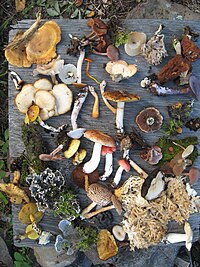
Photo from wikipedia
Quaternary climate fluctuations can affect speciation in regional biodiversity assembly in two non-mutually exclusive ways: a glacial species pump, where isolation in glacial refugia accelerates allopatric speciation, and adaptive radiation… Click to show full abstract
Quaternary climate fluctuations can affect speciation in regional biodiversity assembly in two non-mutually exclusive ways: a glacial species pump, where isolation in glacial refugia accelerates allopatric speciation, and adaptive radiation in underused adaptive zones during ice-free periods. We detected biogeographic and genetic signatures associated with both mechanisms in the assembly of the biota of the European Alps. Age distributions of endemic and widespread species within aquatic and terrestrial taxa (amphipods, fishes, amphibians, butterflies and flowering plants) revealed that endemic fish evolved only in lakes, are highly sympatric, and mainly of Holocene age, consistent with adaptive radiation. Endemic amphipods are ancient, suggesting preglacial radiation with limited range expansion and local Pleistocene survival, perhaps facilitated by a groundwater-dwelling lifestyle. Terrestrial endemics are mostly of Pleistocene age and are thus more consistent with the glacial species pump. The lack of evidence for Holocene adaptive radiation in the terrestrial biome is consistent with faster recolonization through range expansion of these taxa after glacial retreats. More stable and less seasonal ecological conditions in lakes during the Holocene may also have contributed to Holocene speciation in lakes. The high proportion of young, endemic species makes the Alpine biota vulnerable to climate change, but the mechanisms and consequences of species loss will likely differ between biomes because of their distinct evolutionary histories.
Journal Title: Proceedings of the Royal Society B: Biological Sciences
Year Published: 2022
Link to full text (if available)
Share on Social Media: Sign Up to like & get
recommendations!